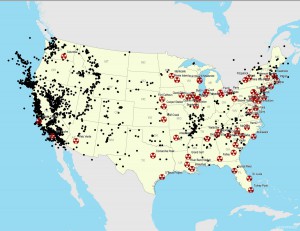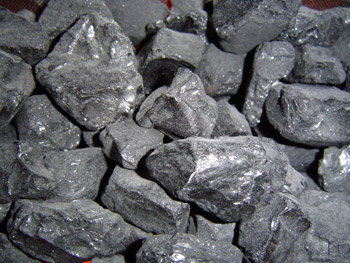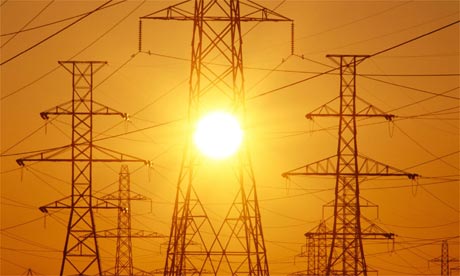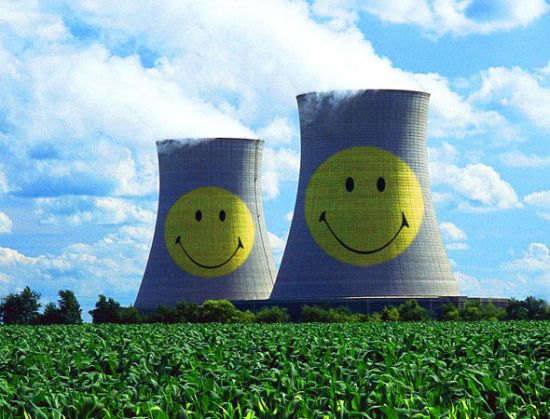The nations energy grid includes everything that we use to keep our nation powered, and how we use the materials and convert them into energy. We have power plants scattered all across the nation that provide power to various areas. There are about 19,023 individual generators at about 6,997 operational power plants in the United States. Without the use of these resources there would be no electricity or power.
 Aerial view of our nations energy grid.
Aerial view of our nations energy grid.
Video below shows how a power plant works.
http://www.youtube.com/watch?feature=player_detailpage&v=GI7AhajfhWE
Energy Infrastructure: Sun, Electricity, Fossil fuels, Nuclear, Renewable Resources.
Sun light is a major source of energy used to supply power to the nation. Sunlight is natural and will never run out. Sunlight warms the planet and transfers heat and pressure in weather patterns. However, most of us use the sun in its secondary form of energy which is fossil fuels. For example, when we burn wood the heat comes from the breaking of bonds which releases energy and light.
According to http://needtoknow.nas.edu/energy/energy-sources/fossil-fuels/ “The United States gets 84% of its total energy from oil, coal, and natural gas, all of which are fossil fuels”. Oil is an efficient way to obtain energy, however it can have a devastating effect on the environment when we constantly burn it in automobiles, factories, etc.
Electricity is a secondary source of energy. It cannot be mined from the ground so it is derived from other sources. Electricity generating plants now consume two-fifths of U.S. energy from all sources, including about 90% of America’s coal and nearly 30% of its natural gas according to http://needtoknow.nas.edu/energy/energy-sources/electricity/
Nuclear energy is the energy released during nuclear fission or fusion, especially when used to generate electricity. About 20% of our nations electricty comes from nuclear energy and about 9% of the total power. According to government experts nuclear power plants is expected to increase by 105 by the year 2030.
Renewable Resources.
Renewable resources such as wind can be used as a power source. Renewable energy is an alternative to fossil fuels. Renewable energy such as wind is clean and produces no greenhouse gas emission. Also, renewable resources in the grid usually require less space.
Over the past decade or so the nations energy crisis has been covered in the media and becoming more of a concern. What will happen when we run out of these fossil fuels that we use to power everyday life? Global warming and other atmospheric conditions are also a concern. What can we do to limit these resources and use them more responsibly.
There are pros and cons to our nations energy grid.
Pros.
The nations energy grid gives power to our entire nation.
The energy grid stimulates the economy and provides thousands of people work in different types of power plants.
Cons
excess energy use is one of the causes of global warming
Pollution, such as air and water
Dangers such as radiation poisoning.





I really enjoyed the video explaining how a power plant works. It was short and to the point but gave all the details necessary to help understand just how we all get power today. Many of us take for granted how much work it takes for each of us to be able to turn light switch.
This is my first time go to see at here and i am in fact pleassant to read everthing at one place.
my web-site – this is the website
It’s alarming to think about the consequences of excessive energy use, such as global warming, iq test free, and pollution. We must find innovative ways to limit our reliance on these finite resources and use them more responsibly.
This post effectively breaks down the various energy sources, including sunlight, fossil fuels, electricity, nuclear energy, and renewable resources, offering a clear understanding of how each contributes to our overall energy infrastructure. The discussion on the pros and cons of the energy grid is particularly enlightening, highlighting the critical balance between powering our nation and the environmental impacts, such as global warming and pollution. This blog serves as an excellent resource for anyone looking to deepen their understanding of the energy sector and the challenges we face in sustainable energy management. It’s like an real iq testfor energy enthusiasts, challenging readers to think critically about the future of energy and our planet.
The discussion on the nation’s energy grid is crucial for our future sustainability. It’s like navigating through different power sources on omegle, each offering unique perspectives and challenges.